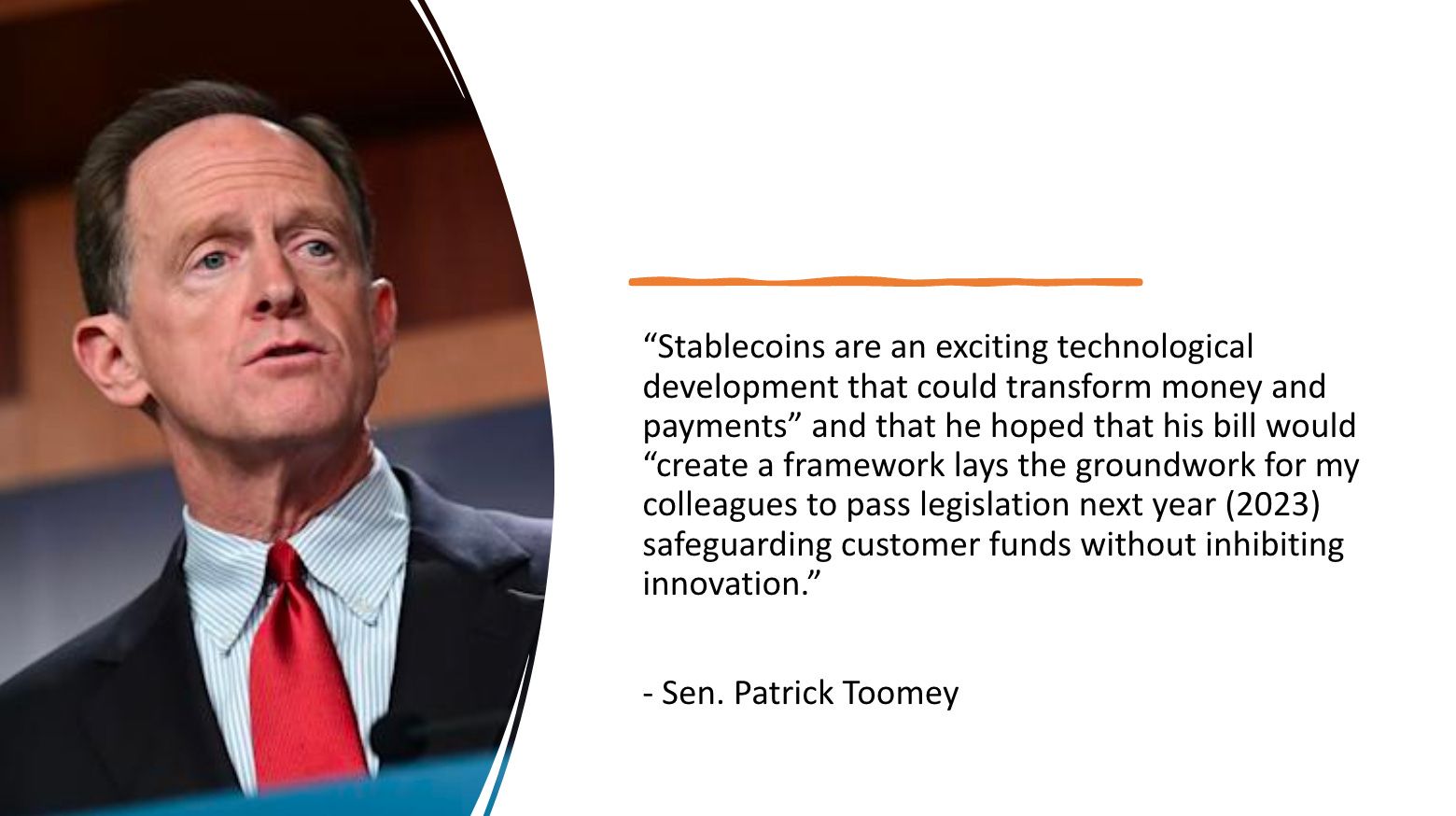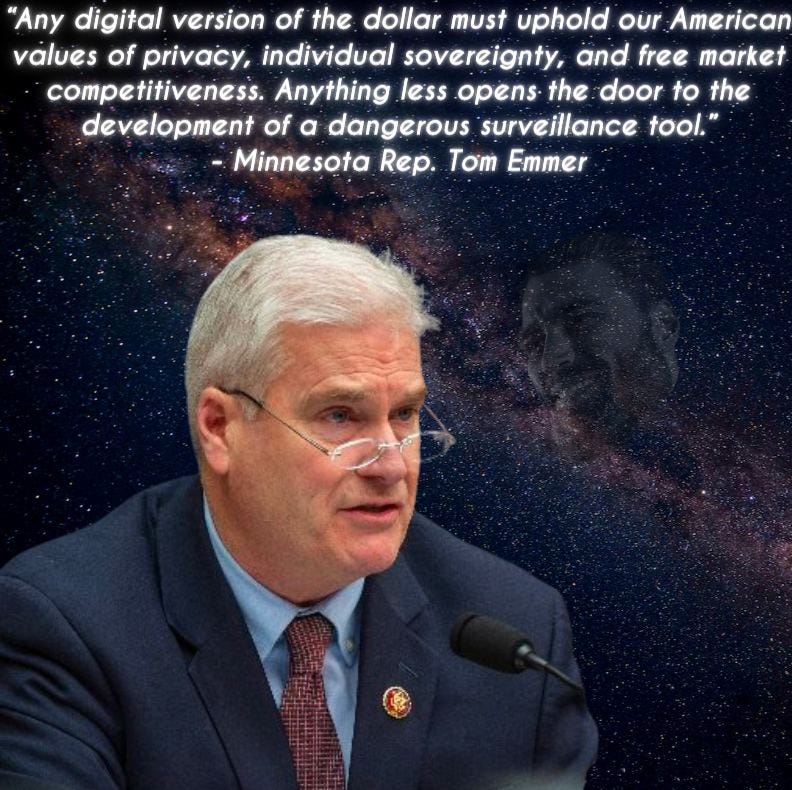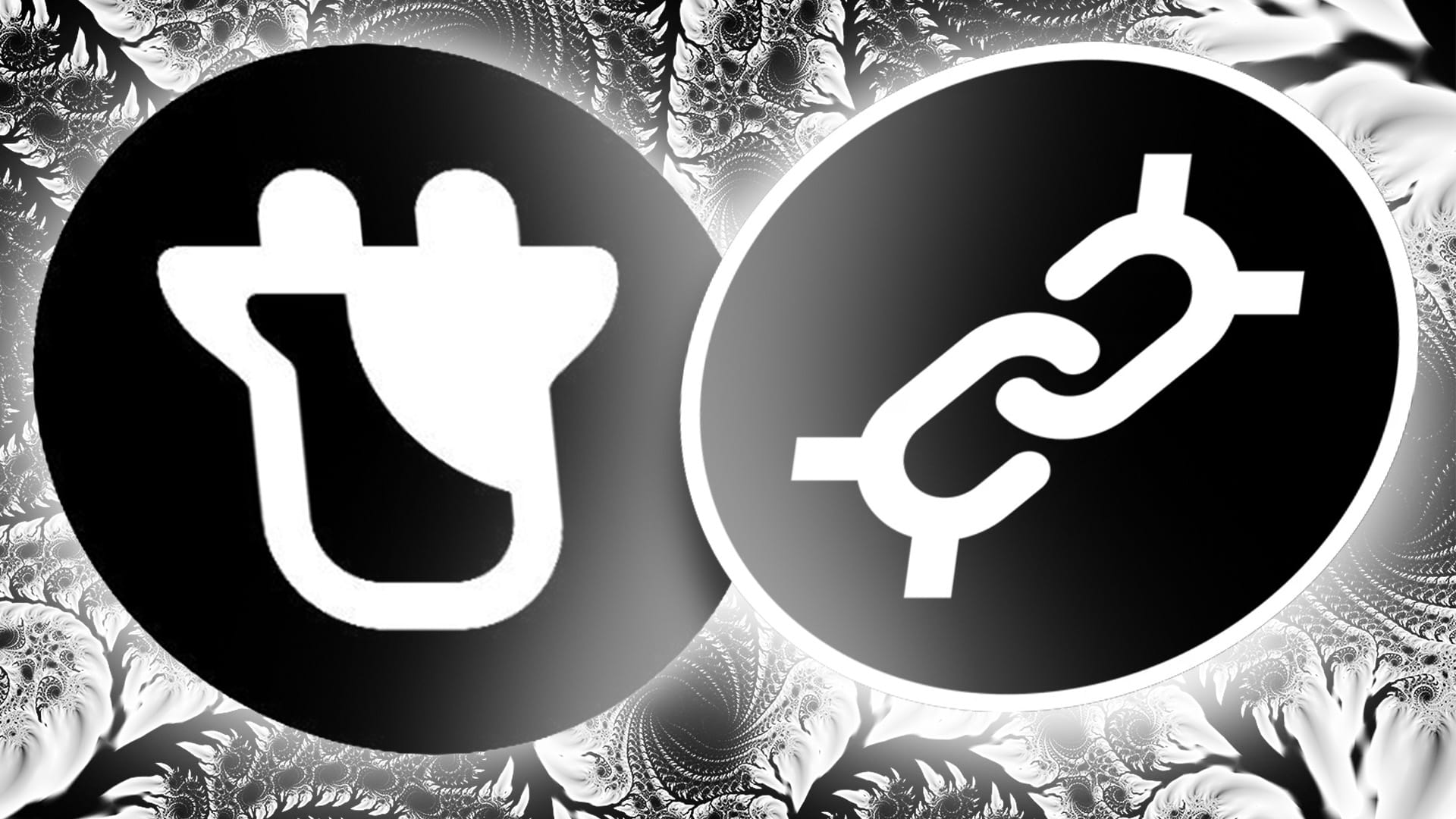The following is the text from my speech at ETH Denver this year about stablecoin regulation. Video will be available soon but you can follow along with the presentation here.
Slide 1
Hey everyone my name is David Liebowitz, better known as DeFi Dave, and I am here to talk to you about the wonderful world of stablecoin regulation. What to expect. And where we go from here.
Slide 2
A little bit about me. I've been in crypto for almost six years and almost half of those years I’ve been involved with stablecoins in some form. I run Flywheel DeFi, a media platform that covers, analyzes, and reports on genuine progress in the space. Another lifetime ago, I was a “hilltern” in Congress. This is given but nothing I say here is legal or financial advice, they are just my observations and conclusions
Slide 3-4
Make no mistake, there is a fierce debate going on in capitol hill about the future of crypto as an industry. Although more legislators than ever see crypto as a promising frontier, the challenge for the industry remains how can we reach across the aisle to the skeptics and come together in a way that will benefit the American economy and bring prosperity to the people. Fortunately, legislation for fiat-backed or commonly referred to as “payment stablecoins” has been proposed and offers a unique opportunity to bring clarity to the current clouded environment. Don’t take it from me.

According to Circle CEO Jeremy Allaire “Stablecoins are the lowest-hanging fruit… It’s the most straightforward. It’s a foundational piece.”
Slide 5
Stablecoins are blockchain-based assets that are pegged to an arbitrary value and there is no denying it, dollar-pegged stablecoins in particular have proven to be the killer application of this technology. Ever since the first stablecoins were launched in 2014, stablecoins have grown to dominate the space in both use cases and conversation. Stablecoins play a vital role in maintaining healthy liquid markets for tokens, allowing users to frictionlessly interact with DeFi in the most efficient way possible. In many cases, transactions that would require days to settle in the real world happen in a matter of seconds. Payment stablecoins make up the vast majority of stablecoins in circulation but a growing minority of stablecoins are backed by crypto or even commodities. Furthermore, stablecoins have found purpose in being paid out in salaries, sent for remittances, and act as a hedge against inflation in unstable economies. In these cases, stablecoins are a lifeline to preserving wealth.
Slide 6
According to a recent survey, 97% of institutional investors agree that tokenization will revolutionize asset management and benefit the industry. The idea of using digital money has grown on institutions, but only if it comes from a trusted player. It is not an exaggeration to say that hundreds of billions if not trillions of dollars are waiting on the sidelines ready to be called into the game. Trusted players don't step onto the field unless the rules are clearly outlined. And when drafting these rules, it's important to keep in mind that…
Slide 7
Stablecoins are NOT cryptocurrencies. Stablecoins are NOT banks. Stablecoins ARE a completely novel form of money that uses a public blockchain ledger to facilitate transactions and keep track of balances. Stablecoins will require separate definitions, distinctions, and guidelines from their counterparts. So what exactly makes a stablecoin a stablecoin?
Slide 8
The foundational core of stablecoins is the social contract between the stablecoin holder and stablecoin issuer; holders receive utility while issuers receive yield. Stablecoin holders are able to retreat to stability on-chain in a frictionless manner and redeem without worry. In exchange, stablecoin issuers earn yield from the underlying reserves but are responsible for being able to reward the cash equivalent of fiat upon request. For example, payment stablecoins allow issuers to earn yield from High Quality Liquid Assets and holders to redeem for fiat at any time. The entire business model of payment stablecoins is centered on being the fiat on/off ramp to the on-chain world.

Slide 9
This is completely different from banks whose primary function is to lend money from deposits, and often, this creates new money in the process that did not exist before. The purpose of banks is to grow the economy by offering credit for people to start businesses, buy houses, etc. An article from the think tank the Official Monetary and Financial Institutions Forum echoes this sentiment and makes the case that “A stablecoin issuer is emphatically not a bank and arguably not a deposit taking institution either. Unlike a fractional reserve bank, it does not create money by generating monetary assets partially backed by depositary liabilities.” Stablecoin issuers do not lend the underlying reserve assets, so they aren't exposed to the ups and downs of market cycles. As long as reserves are only high quality reserve assets such as treasury bills, reverse repo agreements, Government money-market funds, or deposit accounts, the stablecoin will remain redeemable and safe.
Slide 10
Stablecoins are fundamentally a new technology and require a new framework. Are there any frameworks that exist today that we can judge?
Slide 11
Currently at the state level, the New York Department of Financial Services approves of payment stablecoins as a part of their crypto regulatory framework. What New York got right here is that you DO NOT need to be a depository institution to issue a stablecoin.
These rules were outlined in a guidance letter that was sent out in June 2022 and include points such as that the market value of the assets backing the stablecoin must be equal to or greater than the nominal value of all the stablecoins circulating on-chain at the end of each business day, the assets in the reserve backing the stablecoin must be siloed from all other assets by an approved institution, and all stablecoins must have “timely” redemption policies in writing approved in advanced. What the NYDFS guidance does well is it enshrines the already established social contract between issuers and holders. It protects holders by placing rules on what reserves can be, how reserves should be custodied, and what kind of attestation is required for those reserves.
Slide 12
And we have seen what happens if these rules are broken; issuers face being shut down. This is exactly what happened to BUSD last month when it came to light that the stablecoin was not sufficiently backed by its reserves for a period of time.
Slide 13
NYDFS gives guidance at a state level, but what has been proposed at federal level? Several proposals have been made from both the legislative and executive branches over the past few years such as the President’s Working Group report in 2021 on stablecoins and sections of the Lummis-Gillibrand Responsible Financial Innovation Act in the following year, but the most comprehensive bill that has been released is the final version of Senator Toomey’s TRUST act in December 2022 which would establish the first federal regulatory framework for payment stablecoins.
Slide 14
In his final statements before retiring, Toomey proselytized the promise and potential of stablecoins saying that they “are an exciting technological development that could transform money and payments” and that he hoped that his bill would lay the groundwork for his “colleagues to pass legislation next year safeguarding customer funds without inhibiting innovation.” The bill received bi-partisan support and was surprisingly co-sponsored by one of the most well-known anti-crypto advocates Elizabeth Warren. But do not fret, I believe if this bill is passed then it will spark one of the most promising adoption catalysts for the industry.
Slide 15
First and foremost, the bill firmly designates payment stablecoins under the oversight of the Office of the Comptroller of Currency (OCC) which regulates banks and authorizes the office to establish a new federal license specifically for payment stablecoin issuers and allow them to apply for Fed Master Accounts. Because payment stablecoins are under the jurisdiction of the OCC, it explicitly means that they are not securities abd new license officially puts on the books that payment stablecoin issuers do NOT have to be banks. This is an intentional part of the bill to prevent entrenched incumbents from being favored. It does not prevent depository institutions from issuing their own stablecoins, it just means that they won’t be artificially protected by a regulatory moat.

The bill further goes into detail on what is required from issuers and what protections are granted to holders, both of which have been asked by industry participants for years.
For issuers, the bill defines what a payment stablecoin is, the requirements for maintaining a payment stablecoin such as reserves being high quality liquid assets, redemption policies, and attestings of backing. Similar to the NYDFS, it requires stablecoin issuers to separate stablecoin deposits from regular banking activities so it doesn't pose a risk to the system. It is best to think of this separation as a 21st century stablecoin provision of the glass-steagall act but instead of commercial banking and investment banking activities being separated, it's arguably more conservative because issuers are barred from lending!
For holders, the Stablecoin TRUST act provides clear protections for them such as clarifying that they would have priority in the event of an issuer’s insolvency. In addition, the bill makes it a point to prioritize privacy and treats stablecoins as the equivalent of cash. All transactions not involving an intermediary are exempted from the Bank Secrecy Act and do not need to be reported. Based.
Slide 16
When it comes to rules and regulations, payment stablecoins are the first rubicon for both legislators and crypto to cross together. If major payment stablecoin legislation such as the TRUST act were to pass it would be heralded as a bipartisan victory, and both sides can brag about how they are protecting investors and fostering innovation. With the proper guidelines in place, a stablecoin renaissance would commence and will usher in a new era where crypto will be known for its utility rather than speculation.
Slide 17
If 10% of Americans were paid in stablecoins in some form that would constitute over 33 million people and make a sizable voting block. As Jake Chervinsky says so eloquently, There are many tools that crypto supporters can use to promote good, pro-innovation policy at every level of government. But there is nothing—absolutely nothing—that can have a bigger impact on policy than crypto-enabled products and services that millions of people want to use. We actually have a preview of what mass adoption of payment stablecoins would look like in the real-world and it’s probably something you have used in the past week or month.
Slide 18
Services like PayPal, Venmo, Zelle, and Cash App are digital money; they are merely stablecoins held on a private ledger that have the same implicit agreement between holders and issuers. And you can already guess how issuers earn revenue. Venmo spokesperson Josh Criscoe confirmed in a 2018 interview that “Any funds held in PayPal or Venmo are transferred to bank accounts in PayPal’s name. The balances are pooled and held separate from PayPal’s corporate funds, and the company never uses the funds for its operating expenses or any other corporate purposes. As outlined in our user agreements, PayPal owns the interest on the funds.” It is important to note also in their user agreements, in the event of Venmo or PayPal failing, holders are not protected.
Slide 19
To review, private payment stablecoins have existed for some time yet it is the public ledger payment stablecoins that get scrutinized… interesting. If only payment stablecoins were grouped with PayPal, the rhetoric from regulators would be very different.
Slide 20
Looking back on the last session of Congress, after the collapse of Terra, the trilateral negotiations led by Representives Maxine Waters and Patrick McHenry from the House along with the Treasury Department could not get a bill to committee. With the fall of FTX, it all sealed the deal for legislation not passing that session. Yet from their talks, a quote unquote “ugly baby” of a bill was drafted and could be something that is considered in the future.
Slide 21
So what does the appetite look like for stablecoin regulation to get passed? In late January, the administration released a letter urging Congress to mitigate cryptocurrency risk. House Subcommittee on Digital Assets Chair Rep French Hill has stated that passing stablecoin regulation was a top priority of his. The Committee on Financial Services that he is a part of can count outspoken crypto advocate Tom Emmer and the committee’s chair Patrick McHenry as representatives who will push regulation forward that prioritizes protection from over-regulation and fosters innovation. In fact, Emmer recently introduced the CBDC Anti-Surveillance State Act that would act as a check on the Federal Reserve and their CBDC developments. It makes sense though, payment stablecoins are inherent competition to a CBDC that is attempting to gain mass adoption from the populace.
Slide 22
Emmer's biggest concern is that “Any digital version of the dollar must uphold our American values of privacy, individual sovereignty, and free market competitiveness. Anything less opens the door to the development of a dangerous surveillance tool.”
One of the biggest hurdles would be noted critic of cryptocurrencies Sen. Sherrod Brown who is the chair of the banking committee. Any payment stablecoin legislation that hits the Senate floor would need to be marked up by him. But with the proper framing, I am hopeful.

Slide 23
We are in the 11th hour for Congress to act on payment stablecoin legislation to protect not only American investors from insolvent issuers but also over-regulation from the executive branch. If Congress fails to pass legislation, then it is likely that the Federal Reserve will oversee stablecoins which leaves a number of question marks. Most notably, Gary Gensler and the SEC are looking for any reason possible to widen its mandate in the name of protecting investors. A few weeks ago, the SEC informed Paxos that they will be suing them over BUSD alleging that stablecoins are securities. With that form of logic, does that mean PayPal is offering a security when you hold dollars in their custody?
Slide 24
Stablecoins are a global phenomenon and if those seeking to regulate it into the ground have their way before its utility on a grand scale becomes obvious, it will have tremendous ripple effects for the years to come. Stablecoins are growing in use and have a real chance of becoming the dominant form of settlement in the future. If issuers are forced to be pushed offshore then it would be a cataclysmic setback for capital market formation in the US, which is also an area that the SEC is mandated to protect. That’s why we need legislators to act now to pass a sensible framework regarding payment stablecoins because even if they pass laws to overturn regulations that are stamped on the books, it will be too little too late. Forget a bill being an ugly baby because the baby will be dead on arrival. Thank you.




